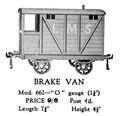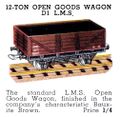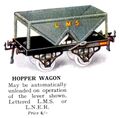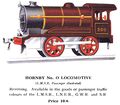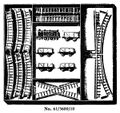Category:London, Midland and Scottish Railway
| The "Big Four" railway companies |
|---|
 |
| Great Western Railway (GWR) |
| London, Midland and Scottish Railway (LMS) |
| London and North Eastern Railway (LNER) |
| Southern Railway (SR) |
1926: Map of LMS routes and sea connections [image info]
1925: "Put your Works on the LMS" [image info]
1928: poster art, "This is your way, Sir" [image info]
1929 poster: "The LMS Collect Carry and Deliver your Parcels" [image info]
London, Midland and Scottish Railway (LMS) The London, Midland and Scottish Railway was the largest of the 'Big Four' railway companies formed in the 1923 grouping. This railway was formed of the London & North Western Railway, the Caledonian Railway, the Lancashire & Yorkshire Railway, and the Midland Railway. It was never as profitable as the other companies but it was a big venture: the British Empire's biggest commercial enterprise, the UK's second largest employer and, at one point, the largest transport organisation in the world. Based at Euston, the LMS operated up the west coast of England, through the Midlands, over the Pennines and up past Glasgow.
Pre-1923 ancestors
- Caledonian Railway (CR)
- Furness Railway
- Glasgow and South Western Railway
- Highland Railway
- Lanacashire and Yorkshire Railway (LYR)
- London and North Western Railway (LNWR)
- London, Tilbury and Southend Railway
- Maryport and Carlisle Railway
- Midland Railway (MR)
- Somerset and Dorset Joint Railway
- Cleator and Workington Junction Railway
- Glasgow and Paisley Joint Line
- Knott End Railway
- Leek and Manifold Light Railway
- Stratford-on-Avon and Midland Junction Railway
- North Staffordshire Railway
- Wirral Railway
- North London Railway (NLR)
1923 overview
The London Midland and Scottish Railway, the largest British system (see map), is made up principally of
the London and North Western, including the Lancashire and Yorkshire, and the Midland railways in England, and of the Caledonian, Glasgow and South Western and Highland railways in Scotland. This great network, with its lines extending into Wales, and across to the East Coast, ramifying throughout Scotland except the South Eastern portion, and possessing extensive running powers over other systems, covers the larger part of Great Britain, except the South of England, though even here it throws out a tentacle through its joint ownership with the Southern railways of the Somerset and Dorset line. The North Staffordshire and Furness, and a number of subsidiary and joint lines, complete the system in Great Britain, and in addition the company at present owns a considerable mileage in the north of Ireland. Its total route mileage in this country is about 8,000 miles. The system also includes about 350 miles of canals.
The company owns a considerable fleet of steam vessels and a number of important docks and harbours. It runs steamship services to Ireland through Holyhead, Liverpool, Heysham and Stranraer, and to the Continent through Goole and Hull. Steamers also navigate the Clyde, the Scottish locks and the English lakes. In addition to the harbours named, the company has docks and wharves at Alloa, Ayr, Barrow, Bristol, Fleetwood, Garston, Gourock, Grangemouth, Largs, Morecambe, Renfrew, Troon, Wemyss Bay, Widnes, on the Thames, and at other places.
The famous locomotive, carriage and wagon works at Crewe of the old London and North Western are now supplemented by works belonging to other constituents at Derby, Horwich, St. Rollox (Glasgow), Kilmarnock, Inverness, Stoke-on-Trent, Barrow, Wolverton, Newton Heath (Manchester) and elsewhere. Doubtless these will be reduced in time, as will also the establishments of the other three companies, by the economies consequent on amalgamation. The company claims to be the largest railway hotel proprietors, controlling some 34 establishments.
The company's main traffic routes serve the majority of the large manufacturing and industrial counties of the Midlands and the North. Apart from its Irish and Scottish services, it also provides through services with the West and South, and besides connecting industrial centres, serves a number of holiday resorts on the Welsh and North West coasts, Isle of Man, Lake district, and in Scotland. A few leading statistics may be of interest.
The company has a capital of about £385 millions. For 1921, the gross receipts from railway operations only were £110,750,000 ; the total expenditure on railway working, £94,600,000 ; and the net receipts, including all items, £20,020,000. The total passenger traffic for the year, apart from holders of season tickets, of which 322,000 were issued, was 338,687,000. The freight traffic included general merchandise, 19,300,000 tons ; coal, coke and other fuel, 47,000,000 tons ; other minerals, 16,150,000 tons; and live stock, 6,937,000. The year 1921 was of course still affected by trade depression.
The rolling-stock owned by the company includes 10,400 steam locomotives, 27,000 coaching vehicles, 315000 freight vehicles, and 22,300 service vehicles. There is also an electric locomotive and 550 electric motor and trailer cars. Considerable increase in the electric rolling-stock of all four companies may of course be expected as electrification proceeds. In 1921 the total engine mileage run, including shunting, was 178,380,000 miles.
The fleet of the company comprises 14 turbine vessels, 51 screw steamers, 7 paddle steamers and a number of smaller boats. The company also owns over 1,000 road vehicles.
The principal headquarters of the company are at Euston Station, London, and it also owns many other fine stations both in London and the provinces and in Scotland. The question of organisation will be referred to later, when the other three systems have been briefly described.
Locomotives
In the beginning, the LMS favoured smaller, lighter locomotives, such as the L&YR’s 0-6-0s and Henry Fowler’s "Compound" 4-4-0 and "Jinty" tank engine. This way they could run smaller trains more frequently, and larger ones could be double-headed if needed. But this did not prove cost-effective, and even two of these locos struggled over the steep inclines of the Settle-Carlisle line and Beattock Summit. So some the slightly larger 4-6-0 "Patriot" and "Royal Scot" classes emerged. But when William Stanier became Chief Mechanical Engineer in 1932, the LMS became a competitor in locomotive power. A former works manager for the Great Western Railway, Stanier designed the railway’s first 4-6-2s: the "Princess Royal" and "Princess Coronation". The "Coronations" in particular were more powerful than the diesels that replaced them. Stanier’s locos were fast too. The original loco "6220 ‘Coronation"” achieved a land speed record of 114 mph on a press run in 1937.
Services
The LMS ran a large number of passenger services to Scotland. "The Royal Scot" was inherited from the LNWR, and ran from Euston to Glasgow. The "Coronation Scot", commissioned in 1937 to commemorate the crowning of George VI, was noted for its use of streamlined "Coronation" locos, with an art deco blue and silver cheat-striped livery.
Subcategories
This category has the following 8 subcategories, out of 8 total.
C
D
- Duchess Class locomotives (4 P, 8 F)
G
- George the Fifth Class locomotives (5 P, 12 F)
R
- Caledonian Railway (3 P, 9 F)
- Midland Railway (8 P, 8 F)
- North London Railway (1 P)
- Royal Scot (locomotive) (8 P, 24 F)
Pages in category ‘London, Midland and Scottish Railway’
The following 79 pages are in this category, out of 79 total.
B
C
- City of Liverpool locomotive 46247 (Hornby Dublo 3226)
- Coal Wagon LMS 210112 (Hornby Dublo D1)
- Coal Wagon LNER 404844 (Hornby Dublo D1)
- Coronation 6220 locomotive paperweight, small (Bassett-Lowke)
- Coronation 6220 locomotive, blue (Trix Twin Railways, modified)
- Coronation locomotive 6220 (Bassett-Lowke)
- Coronation locomotive 6220 (Hornby R.685)
- Coronation locomotive 6220 (Hornby R.864)
- Coronation Scot First Class Brake Car 6202 (Exley for Bassett-Lowke)
- Coronation Scot First Class Car 7720 (Exley for Bassett-Lowke)
- Coronation Scot Kitchen Car 2704 (Exley for Bassett-Lowke)
- Coronation Scot Kitchen Car 2707 (Exley for Bassett-Lowke)
- Coronation Scot Restaurant Car 7507 (Exley for Bassett-Lowke)
- Coronation Scot Third Class Brake Car 7602 (Exley for Bassett-Lowke)
- Coronation Scot Third Class Car 4104 (Exley for Bassett-Lowke)
- Coronation Scot Third Class Car 4107 (Exley for Bassett-Lowke)
- Coronation Scot Third Class Car 5027 (Exley for Bassett-Lowke)
- Coronation Scot US Tour presentation set 2/347 (Trix Twin Railways)
D
F
L
- LMS 2-4-0 electric tank locomotive (Bing Table Railway)
- LMS Brake 3rd Class coach 5792, Coronation Scot (Hornby R.423)
- LMS Delivery Van (Triang Minic 80M)
- LMS First Class coach 1070, Coronation Scot (Hornby R.422)
- LMS Goods Train set with loco 5049 (Trix Twin Railway 2/324)
- LMS locomotive 6161 (Hornby Series)
- LMS open wooden wagon, M (Tri-Ang)
- LMS wooden goods wagon, M (Tri-Ang)
- LMS wooden locomotive M (Tri-Ang)
- LMS wooden locomotive size A (Tri-Ang)
- Locomotive BR 62750 "Pytchley" (Trix Twin Railway)
- Locomotive LMS 0-4-0, No1 Tank Loco (Hornby Series)
- Locomotive LMS 1168 (Trix Twin Railway)
- Locomotive LMS 1185 (Hornby Series E220)
- Locomotive LMS 2051, Tank Loco No2 (Hornby Series)
- Locomotive LMS 8712, No1 Special (Hornby Series)
- Locomotive No2 Special, LMS 1185 (Hornby Series)
- Lumber Wagon No.2, LMS (Hornby Series)
N
P
- Passenger coach, 3rd class, LMS 8512 (Leeds)
- Passenger composite coach, 3rd class, LMS 6140 (Leeds)
- Passenger Train Set LMS 5600 (Hornby No 501)
- Passenger Train Set SR E 126 Tank Loco (Hornby Trains)
- Passenger Train Set, LMS 5600 (Hornby Trains)
- Princess Elizabeth locomotive 6201 (Hornby Series)
- Princess Elizabeth locomotive 6201 (Trix Twin Railway)
- Princess Elizabeth locomotive 6201, in presentation case (Hornby Series)
R
T
- Tank Goods Train Set, LMS 2180, No2 Special Tank (Hornby Series)
- Tank Goods Train Set, LMS 2270, No101 (Hornby Trains)
- Tank loco LMS 169, 0-4-4 (Bonds of Euston Road)
- Tank Locomotive 2180, No2 Special (Hornby Series)
- The Hornby Book of Trains (1928-29)
- The Hornby Book of Trains (1929-30)
- The Hornby Book of Trains (1930-31)
- The Hornby Book of Trains (1931-32)
- The Hornby Book of Trains (1932-33)
- The Hornby Book of Trains (1933-34)
- The Hornby Book of Trains (1934-35)
- The Hornby Book of Trains (1937-38)
- The Royal Scot in America, 1933
Media in category ‘London, Midland and Scottish Railway’
The following 114 files are in this category, out of 114 total.
- Barrow Docks, LMS (TRM 1925-09).jpg 1,450 × 2,200; 821 KB
- Bassett-Lowke 2-6-2 LMS 94 Tank Locomotive restoration (Chris Littledale).jpg 1,705 × 1,800; 665 KB
- Bassett-Lowke Garden Railways George the Fifth, overview (BL-MR 1937-11).jpg 2,296 × 1,622; 645 KB
- Bassett-Lowke Garden Railways George the Fifth, specifications (BL-MR 1937-11).jpg 1,561 × 2,177; 513 KB
- Bassett-Lowke Garden Railways Royal Scot 6100, overview (BL-MR 1937-11).jpg 2,202 × 1,529; 641 KB
- Bassett-Lowke Garden Railways Royal Scot 6100, specifications (BL-MR 1937-11).jpg 1,465 × 2,287; 547 KB
- Bassett-Lowke, LMS 5900 Claughton (BL-MR 1937-11).jpg 1,517 × 2,136; 557 KB
- Bassett-Lowke, LMS LNER, 2-6-0, gauge 1 (BL-MR 1937-11).jpg 765 × 1,087; 246 KB
- Bassett-Lowke, Princess Elizabeth, gauge 0 (BL-MR 1937-11).jpg 1,536 × 2,164; 511 KB
- Bassett-Lowke, Royal Scot 6100, gauge 0 (BL-MR 1937-11).jpg 1,511 × 2,169; 571 KB
- Beyer-Garratt articulated locomotive LMS 4994 (RWW 1935).jpg 3,000 × 2,021; 2.74 MB
- Beyer-Garratt loco LMS 4999, gauge 0 model Train Running Day (2016-12).jpg 2,200 × 1,242; 1.52 MB
- Beyer-Garratt loco LMS 4999, gauge 0.jpg 2,200 × 1,238; 1.57 MB
- Brake Van, Bowman Models 662 (BowmanCat ~1931).jpg 1,358 × 1,309; 545 KB
- Cattle Truck LMS, Hornby Dublo D1 (HBoT 1939).jpg 555 × 489; 77 KB
- Cattle Truck, Märklin E1989-0 (MarklinCRH ~1925).jpg 1,388 × 965; 445 KB
- Closed Goods Truck, Märklin 2882-0 (MarklinCRH ~1925).jpg 1,203 × 1,106; 463 KB
- Coal Truck, LMS LNER, Märklin 1920-0 (MarklinCRH ~1925).jpg 1,359 × 923; 327 KB
- Coal Wagon, Hornby Dublo D1 (HBoT 1939).jpg 1,144 × 940; 177 KB
- Coronation Scot nine-car train (Bassett-Lowke).jpg 1,200 × 562; 468 KB
- Corridor Coach Brake-Third LMS, Hornby Dublo D3 (HBoT 1939).jpg 934 × 479; 115 KB
- Corridor Coach First-Third LMS, Hornby Dublo D3 (HBoT 1939).jpg 1,039 × 482; 146 KB
- Duchess of Atholl 6231, Hornby Dublo loco EDLT2 (HBoT 1939).jpg 2,000 × 521; 94 KB
- Duchess of Atholl Train Set Hornby Dublo EDP2 (HBoT 1939).jpg 3,303 × 2,478; 1.11 MB
- Furniture Container, LMS K61, Hornby Series (MM 1936-09).jpg 734 × 655; 130 KB
- Goods Brake Van LMS, Hornby Dublo D1 (HBoT 1939).jpg 575 × 519; 73 KB
- Goods Van 12-Ton LMS, Hornby Dublo D1 (DubloBrochure 1938).jpg 499 × 483; 73 KB
- Goods Van 12-Ton LMS, Hornby Dublo D1 (HBoT 1939).jpg 562 × 498; 72 KB
- Goole Steam Shipping, LMS (TRM 1925-09).jpg 798 × 1,200; 321 KB
- Grangemouth Docks, LMS (TRM 1925-09).jpg 1,472 × 2,200; 827 KB
- HBOT 1938-39 p14 Princess Elizabeth loco.jpg 1,636 × 1,221; 345 KB
- High-Sided Wagon LMS, Hornby Dublo D2 (HBoT 1939).jpg 577 × 511; 80 KB
- Hornby Crane Truck (1925 HBoT).jpg 761 × 735; 64 KB
- Hornby E120 Locomotive LMS 1000 (HBoT 1934).jpg 1,921 × 1,317; 333 KB
- Hornby E120 Special Tank Locomotive LMS 15500 (HBoT 1934).jpg 2,013 × 1,461; 373 KB
- Hornby E220 Special Locomotive, LMS 1185 (HBoT 1934).jpg 1,961 × 1,477; 402 KB
- Hornby Gas Cylinder Wagon (1925 HBoT).jpg 747 × 536; 44 KB
- Hornby Hopper Wagon, LMS LNER (1925 HBoT).jpg 717 × 706; 66 KB
- Hornby M3 Tank Locomotive, LMS 2270 (HBoT 1934).jpg 2,001 × 1,414; 321 KB
- Hornby Milk Traffic Van (1925 HBoT).jpg 733 × 679; 74 KB
- Hornby No.0 Goods Set, LMS (1925 HBoT).jpg 3,000 × 1,200; 584 KB
- Hornby No.0 Passenger Set, LMS (1925 HBoT).jpg 3,113 × 1,125; 682 KB
- Hornby No.1 Goods Set, LMS (1925 HBoT).jpg 2,849 × 1,079; 590 KB
- Hornby No.1 Luggage Van (1926 HBoT).jpg 847 × 649; 84 KB
- Hornby No.1 Luggage Van LMS LNER (1925 HBoT).jpg 875 × 660; 72 KB
- Hornby No.1 Lumber Wagon (1925 HBoT).jpg 847 × 565; 56 KB
- Hornby No.1 Passenger Set, LMS (1925 HBoT).jpg 2,831 × 936; 530 KB
- Hornby No.1 Tank Goods Set, LMS (1925 HBoT).jpg 3,029 × 961; 408 KB
- Hornby No.1 Tank Loco, LMS (1925 HBoT).jpg 950 × 750; 105 KB
- Hornby No.1 Tank Loco, LMS Goods (1925 HBoT).jpg 950 × 750; 105 KB
- Hornby No.2 Goods Set, LMS (1925 HBoT).jpg 3,200 × 1,024; 389 KB
- Hornby No.2 Luggage Van LMS LNER (1925 HBoT).jpg 900 × 590; 80 KB
- Hornby No.2 Pullman Set, LMS (1925 HBoT).jpg 1,990 × 821; 273 KB
- Hornby No.2 Pullman Set, LNER (1925 HBoT).jpg 2,052 × 741; 304 KB
- Hornby No.2 Tank Goods Set, LMS (1925 HBoT).jpg 2,000 × 579; 178 KB
- Hornby No.2 Tank Loco, LMS (1925 HBoT).jpg 1,450 × 800; 160 KB
- Hornby No.2 Tank Loco, LMS Goods (1925 HBoT).jpg 1,450 × 800; 173 KB
- Hornby No.2 Tank Passenger Set, LMS (1925 HBoT).jpg 1,505 × 413; 120 KB
- Hornby No.2 Timber Wagon (1925 HBoT).jpg 959 × 477; 53 KB
- Hornby No0 Locomotive LMS 8324 (HBoT 1930).jpg 1,568 × 803; 168 KB
- Hornby No0 Locomotive, LMS 500 (HBoT 1934).jpg 2,085 × 1,821; 368 KB
- Hornby No1 Special Locomotive, LMS 4525 (HBoT 1930).jpg 1,529 × 747; 163 KB
- Hornby No1 Special Locomotive, LMS 4525 (HBoT 1934).jpg 2,044 × 1,578; 353 KB
- Hornby No1 Special Locomotive, LMS 8712, detail.jpg 1,024 × 575; 367 KB
- Hornby No1 Tank Locomotive, LMS ~2140 (HBoT 1934).jpg 1,949 × 1,720; 345 KB
- Hornby No2 Special locomotive, LMS 1185 (HBoT 1938).jpg 1,586 × 1,094; 172 KB
- Hornby No2 Special Locomotive, LMS 1185, detail.jpg 1,024 × 574; 399 KB
- Hornby No2 Special locomotives (HBoT 1938).jpg 3,276 × 2,500; 1.15 MB
- Hornby No3 Locomotive LMS 6100 Royal Scot (HBoT 1930).jpg 2,702 × 986; 336 KB
- Hornby No3 Locomotive, LMS 6100 Royal Scot (HBoT 1938).jpg 3,001 × 1,963; 632 KB
- Hornby No3 locomotive, LMS 6100 Royal Scot, detail.jpg 1,024 × 576; 316 KB
- Hornby Railways catalogue, front cover (HRCat 1978).jpg 2,400 × 1,697; 999 KB
- Hornby Refrigerator Van LMS LNER (1925 HBoT).jpg 711 × 647; 64 KB
- Hornby Series M No3 Goods Set (1926 HBoT).jpg 1,860 × 669; 204 KB
- Jackie Cooper on the Footplate, locomotive 6100 Royal Scot (TRS 1933).jpg 1,200 × 889; 223 KB
- Leeds (LMC) Vestibule Brake Composite Coach (SRMT 1939).jpg 2,478 × 1,319; 543 KB
- Leeds (LMC) Vestibule Coach (SRMT 1939).jpg 2,465 × 1,241; 508 KB
- Leeds composite coach 6140.jpg 1,024 × 768; 391 KB
- Leeds passenger coach 8512, detail.jpg 1,024 × 768; 397 KB
- LMS 2309, 2-6-4 locomotive, gauge 1 (Denis Hefford).jpg 2,000 × 1,124; 470 KB
- LMS 4-4-0 locomotive 4-536 (TTRcat 1939).jpg 1,600 × 630; 205 KB
- LMS 4973, Thirty Beyer-Garrats for the LMS, JW Roberts (BPQR 1931-01).jpg 1,837 × 2,500; 1.16 MB
- LMS Beyer-Garratt recoaling (MM 1937-10).jpg 2,202 × 2,290; 2.44 MB
- LMS clockwork freight train set, Bing Table Railway 61-3600-10 (BingCatEn 1928).jpg 1,200 × 1,134; 380 KB
- LMS Large Cattle Truck, ERG (CRSHTB ~1944).jpg 1,600 × 1,056; 1.11 MB
- LMS Standard Wooden Coaches (Milbro 1930).jpg 2,605 × 2,046; 786 KB
- LMS Warehousing (TRM 1925-09).jpg 799 × 1,200; 287 KB
- LMS wooden tank locomotive floor toy (Triang).jpg 1,200 × 674; 359 KB
- Locomotive 4-4-0, LMS, Märklin E1020 (MarklinCRH ~1925).jpg 2,404 × 1,291; 1.18 MB
- Locomotive 4-6-0, LMS, Märklin G1020 (MarklinCRH ~1925).jpg 2,490 × 1,155; 1.12 MB
- Log Truck, LMS LNER, Märklin 2884-0 (MarklinCRH ~1925).jpg 1,433 × 1,108; 448 KB
- London Coal Traffic on the LMS (MM 1937-10).jpg 1,204 × 1,600; 577 KB
- Luggage Van, LMS LNER, Märklin 2876-0 (MarklinCRH ~1925).jpg 2,326 × 1,234; 1,011 KB
- Luggage Van, Märklin 2872-0 (MarklinCRH ~1925).jpg 1,357 × 1,273; 553 KB
- Luggage Van, Märklin 2874-0 (MarklinCRH ~1925).jpg 1,828 × 1,469; 760 KB
- Map of LMS routes (TRM 1926-06).jpg 2,172 × 3,545; 1.75 MB
- Map, North American Tour of the Royal Scot (TRS 1933).jpg 1,200 × 957; 259 KB
- Meat Van LMS, Hornby Dublo D1 (HBoT 1939).jpg 566 × 515; 84 KB
- Newfoundland locomotive, LMS 5573 (Marklin gauge 0).jpg 1,200 × 673; 560 KB
- Open Goods Truck, Bing Table Railway 3302-24 (BingCatEn 1928).jpg 406 × 315; 32 KB
- Open Goods Wagon 12-Ton LMS, Hornby Dublo D1 (HBoT 1939).jpg 571 × 494; 71 KB
- Open Wagon, Bowman Models 661 (BowmanCat ~1931).jpg 1,316 × 1,045; 381 KB
- Put your Works on the LMS (TRM 1925-01).jpg 1,675 × 2,500; 1.38 MB
- Railway Mechanical Horse and Trailer Van, Dinky Toys 33r (MCat 1939).jpg 1,476 × 949; 172 KB
- Refrigerator Car, Märklin 2883-0 (MarklinCRH ~1925).jpg 1,188 × 936; 382 KB
- Royal Scot 6100 (TRS 1933).jpg 1,200 × 858; 205 KB
- Royal Scot 6100 with bell and headlamp for US tour (TRS 1933).jpg 1,573 × 2,500; 3.15 MB
- Royal Scot at Winnipeg, with Mounties Guard (TRS 1933).jpg 1,200 × 837; 224 KB
- The LMS Collect Carry and Deliver your Parcels (TRM 1929-05).jpg 1,008 × 1,600; 567 KB
- The Royal Scot and her 49 sisters (TRM 1928-12).jpg 1,435 × 2,200; 634 KB
- This is your way Sir, LMS poster (TRM 1928-05).jpg 1,700 × 2,500; 1.01 MB

















